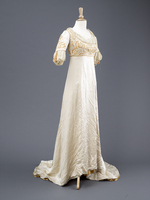Pewter - Poor Man's Silver
Items have been made out of pewter since ancient Egyptian times. It was introduced to Britain by the Romans in the Second Century. Pewter items were often made by silversmiths as a cheaper alternative to silver. As such, it is often called 'Poor Man's Silver'. It is an alloy of mainly tin, with other metals such as bismuth, copper and lead, to harden and strengthen it. Pewter can be worked in several ways to produce different objects. It can be rolled, cast, pressed, spun or shaped by hand. A great variety of objects have been made from pewter including mugs, tankards, plates, dishes, candlesticks, tea services and jewellery. Its surface can be embellished by hammering, engraving or polishing. Pewter tankards were often decorated with 'wriggle-work' which was a line of zig-zag engraving. #SUBHEADING#Marks On Pewter#SUBHEADINGEND# #IMAGE#The museum collections contain several pewter items including brooch, plates, dishes and tankards or mugs. Some of these are stamped with a crowned 'X' mark. This mark was introduced to show that the pewter was good quality. Many items are stamped with the maker's trademark which is also known as a 'touch mark'. This often includes the maker's initials or whole name. One tankard bears the company name stamp of 'Yates & Birch' who were based in Birmingham and used this mark on their wares around 1800. Tankards often bear a stamped capacity mark of 'pint', 'half pint' or 'quart'. The measure had to be verified by an inspector. Each city or town had its own verification mark between 1826 and 1878. After this, the mark comprised of the initials of the reigning monarch ('VR' or 'ER') and a number signifying the town/city location. Two tankards bear the number '528', denoting verification in the county of Lincoln and one has the number '41' to say it has been checked in Hull. Many pewter items, like silver, were marked with the initials, monogram or crest of their owner. One of the tankards in the collection bears a simple triad of initials on the handle. Two tankards bear the stamped three crowns of Hull crest accompanied by the word 'HULL'. These may refer to them being made, sold or used by public houses in Hull. #IMAGE# #SUBHEADING#Bottoms Up!#SUBHEADINGEND# One of the pewter tankards in the collection has a glass bottom. It is thought that the feature helped men to avoid being trapped into conscription by the press-gang. Men could only be forced in to joining the King's Navy if it could be said that they had taken the 'King's shilling'. Members of the press gang visited public houses and offered to buy men drinks and secretly slipped a shilling into the tankard. At the end of the drink, the shilling would reveal itself and the men would be forced to join up. When publicans realised this was happening, they introduced tankards with a glass bottom. Drinkers could raise their tankards to see if there was a shilling lurking in their ale. It is thought that the expression 'Bottoms Up'' derives from this. Tankards continued to be made with glass bottoms long after this time. The one in the collections contains a presentation message that is dated 1902, although the tankard itself may be older.
 Home and Leisure Life
Home and Leisure Life
This section contains stories about what people used to do in their leisure time and about their homes. People have always played games since ancient times. Some stories explore the types of pastimes there once were. Leisure time was not just about playing games. Sewing at home was once a very popular hobby. One story is about the Singer sewing machines that were often used. Leisure activities that took place outside the home included watching puppet theatres. Two stories take a look at what everyday items in the home are made from, including toothpaste!






